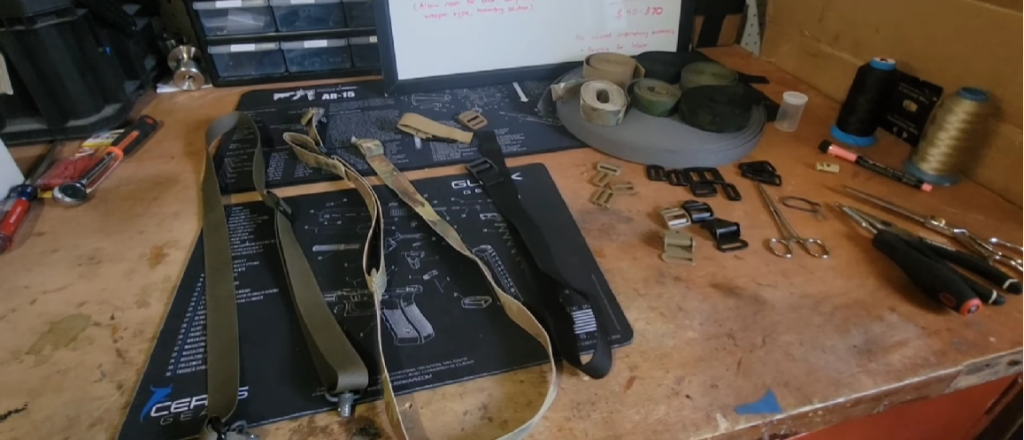Rifle slings come in all shapes, sizes, colors, and materials. No two slings are exactly alike and there are many different types to choose from.

Each type of sling has its own advantages and disadvantages, so it is important to understand the differences before making your selection.
Types of Rifle Slings:
There are a variety of types of rifle slings available on the market today. Some of the most common types include single-point, two-point, three-point, and adjustable slings. Single-point slings allow for quick maneuverability and ease of use while two-point slings provide more stability when shouldering your rifle.
Three-point slings are best suited for tactical or competitive shooting where quick transitions are needed. Adjustable slings allow you to adjust the length of the sling to fit your needs.
Materials Used for Rifle Slings:
The materials used in rifle slings vary depending on the type of sling and its intended purpose. Common materials used include nylon webbing, leather, neoprene, and paracord. Nylon webbing is a popular choice due to its durability and low cost while leather provides an attractive finish that is also comfortable against the skin.

Neoprene is lightweight yet strong and can be used in wet or humid conditions without becoming damaged or stretched out over time. Paracord has become increasingly popular due to its versatility as it can be used for a variety of tasks from lashing equipment together to creating makeshift shelter if necessary.
Advantages of Rifle Slings:
Rifle slings provide numerous advantages for shooters ranging from increased stability when taking aim to comfort during long periods of use. They also help reduce fatigue by evenly distributing weight across both shoulders rather than just one when using a traditional shoulder strap design. Additionally, they provide an extra layer of safety by keeping your firearm securely attached to your body at all times rather than allowing it to dangle freely while you move around or hike through rough terrain.
Disadvantages of Rifle Slings:
While there are many benefits associated with using a rifle sling, there are also some potential drawbacks as well such as an increase in bulk when traveling with your firearm or simply carrying it around town due to the added length provided by the sling itself. Additionally, they may require additional maintenance depending on their construction such as occasionally lubricating metal hardware or cleaning certain materials like leather if exposed to moisture over time which can add more work into your regular firearm maintenance routine.
Length Adjustment of Rifle Slings:
The length adjustment feature found on certain rifle sling designs allows you to customize the fit for maximum comfort and improved accuracy when shooting at longer distances by providing just enough tension between you and your firearm without being too tight or loose which could affect your aim negatively over time if not properly adjusted prior to use.
This feature is especially helpful when transitioning between different styles of firearms such as switching from a long gun like a hunting rifle back to a handgun which requires less slack in order maintain proper accuracy while aiming down sights at targets further away than usual.
Different Attachment Options for Rifle Slings:
The most common way to attach a rifle sling is by using sling swivels. These swivels can be attached directly to the stock of the gun or may require a special adapter that fits into the stock’s swivel studs. Other attachment options include quick detach clips, straps that loop around the barrel or forend, and snap-hooks that attach to a belt loop or other strap.
Comfort Level of Rifle Slings:
When choosing a rifle sling, it is important to consider the comfort level it provides. Many different materials are used in the construction of rifle slings including leather, nylon, cotton webbing, neoprene and synthetic fabrics. Some materials have more padding than others which can affect how comfortable they are to use while shooting.

Rifle slings come in two types: adjustable and non-adjustable. Adjustable models allow you to customize the length of the sling for your particular shooting needs. Non-adjustable models are typically less expensive but do not offer as much flexibility when it comes to length adjustment.
Price Range of Different Rifle Slings:
The price range for rifle slings can vary greatly depending on factors such as material used, brand name, and construction quality. Generally speaking, basic nylon webbing models will cost less than leather or synthetic fabric models with more features. Such as additional padding or adjustable length straps.
Factors to Consider Before Buying a Rifle Sling:
When shopping for a new rifle sling there are several factors that should be taken into consideration before making your purchase. These include comfort level (material used), attachment options (swivel studs or other), adjustability (if needed) and price range (budget). Additionally, consider what type of shooting you will be doing with your firearm. Such as hunting or target practice so you can choose the best style for your needs.
No two rifle slings are exactly alike, and each type has its own set of advantages and disadvantages. It is important to consider the type of sling you need based on your intended use. The materials used, and whether or not the length is adjustable before making your selection. With so many options available on the market, finding the best rifle sling for your needs should never be a difficult task.
FAQ & Answers:
What is the most common way to attach a rifle sling?
The most common way to attach a rifle sling is by using sling swivels. Which can be attached directly to the stock of the gun or may require an adapter. That fits into the stock’s swivel studs.
What type of materials are used in making rifle slings?
Materials commonly used in making rifle slings include leather, nylon, cotton webbing, neoprene. And synthetic fabrics which all have varying levels of comfort when worn while shooting